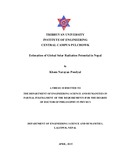Please use this identifier to cite or link to this item:
http://archive.nnl.gov.np:8080/handle/123456789/398| Title: | Estimation of global solar radiation potential in Nepal |
| Authors: | Poudyal, Khem Narayan |
| Keywords: | Global Solar Radiation -- Nepal Solar Radiation |
| Issue Date: | 24-Nov-2017 |
| Abstract: | This research work aims to estimate and measure the daily global solar radiation (GSR) using CMP6 pyranometer at low altitude of Biratnager (26.45° N, 87.27° E, and 72 m), mid altitude of Pokhara (28.22° N, 83.32° E, 800 m), high altitude of Lukla (27.69° N to 86.73° E, 2850 m) and metropolitan city Kathmandu (27.72°N, 85.5°E, and 1350 m) since 2009. The annual average GSR in Biratnagar, Pokhara, Lukla and Kathmandu was 4.21, 4.87, 3.70, and 4.69 kWh/m2/day respectively. There is an average 10.81 percent increment of GSR (average 0.48 kW/m2/day) per km with increase in altitude on clear sky days (Paper I and II). In addition, Kathmandu is located about 550 m above Pokhara even though the GSR values are more in Pokhara than in Kathmandu. This might be due to the result of special topography with the bowl shaped valley, and local weather condition which is different than in Pokhara. The measured data was also used to study the diurnal, monthly, and seasonal variation of GSR. The maximum value of GSR was found during the spring season and minimum in winter. However, in Lukla, the minimum amount of GSR was found in summer due to more cloudy days. In Lukla, coefficient of determination was obtained as high as 0.97 that ensures the strong relationship between cloud transmittance factor and clearness index (Paper III). The modified Angstrom-type equation was used to find the regression coefficients. The regression coefficients, ‘a’ and ‘b’ were calculated as (0.40, 0.15), (0.43, 0.23) and (0.21, 0.26) for Biratnagar (BRT), Pokhara (PKR) and Kathmandu (KTM) respectively. The regression coefficients and sunshine duration are utilized to estimate the GSR for the years from 2011 to 2013 in the three sites BRT, PKR and KTM. The obtained regression coefficients and sunshine duration were used to estimate GSR where there is no ground based data (Paper IV). The Donatelli-Campbell-Bristow-Bellocchi (DCBB) model was selected to estimate GSR. Calibrating and validating this model with statistical tools, obtained coefficients, maximum and minimum temperatures were utilized to estimate the GSR for Kathmandu, Nepal (Paper V). Coefficients of DCBB model and temperatures (Tmax, Tmin) were used for the prediction of GSR for different years 2010, 2012 and 2013. The predicted value of GSR in KTM for the year 2020 is estimated to be 5.38 kWh/m2/day. Calculation shows one percent of the total area of Nepal can generate solar PV energy and solar thermal energy is 798.48 x 106 kWh and 1479.37 x 106 kWh per day respectively. |
| Description: | A thesis submitted to the Department of Engineering Science and Humanities in partial fulfillment of the requirements for the Degree of Doctor of Philosophy in Physics, Lalitpur, Nepal, 2015 |
| URI: | http://103.69.125.248:8080/xmlui/handle/123456789/398 |
| Appears in Collections: | 600 Technology (Applied sciences) |
Files in This Item:
| File | Description | Size | Format | |
|---|---|---|---|---|
| PhD Thesis 2015 (KHEM POUDYAL) pdf file (1) (1).pdf | 8.97 MB | Adobe PDF |  View/Open |
Items in DSpace are protected by copyright, with all rights reserved, unless otherwise indicated.